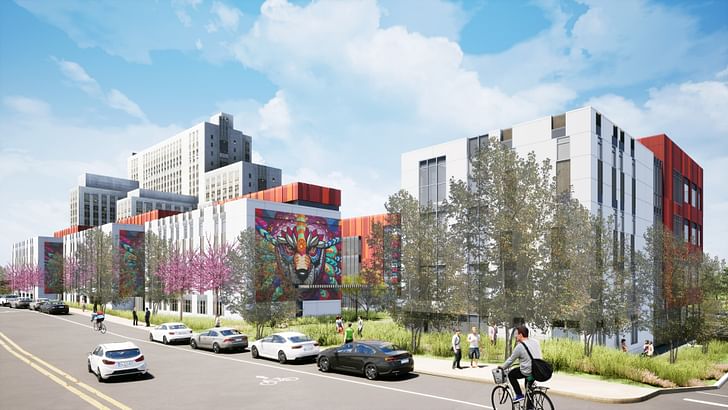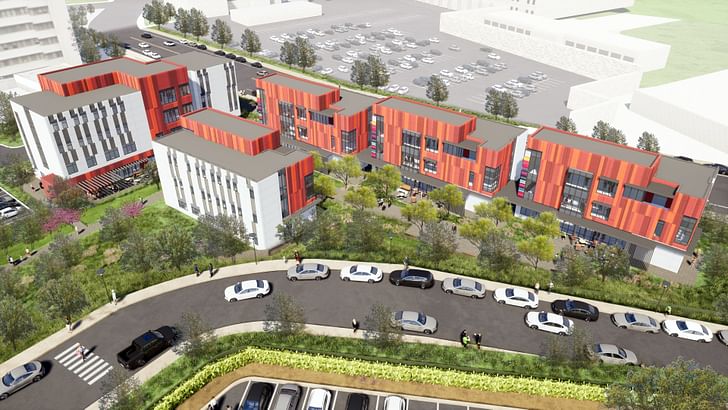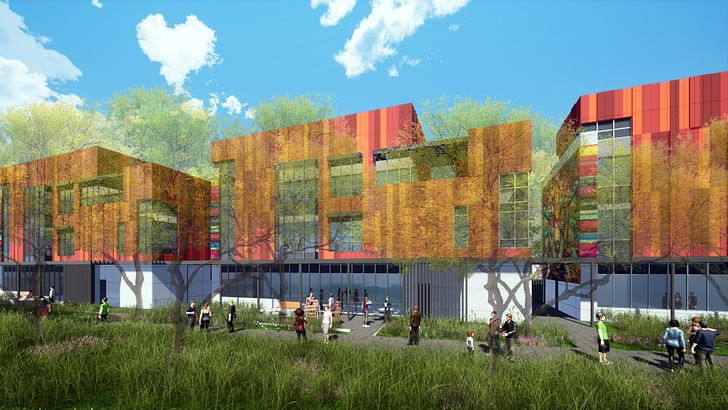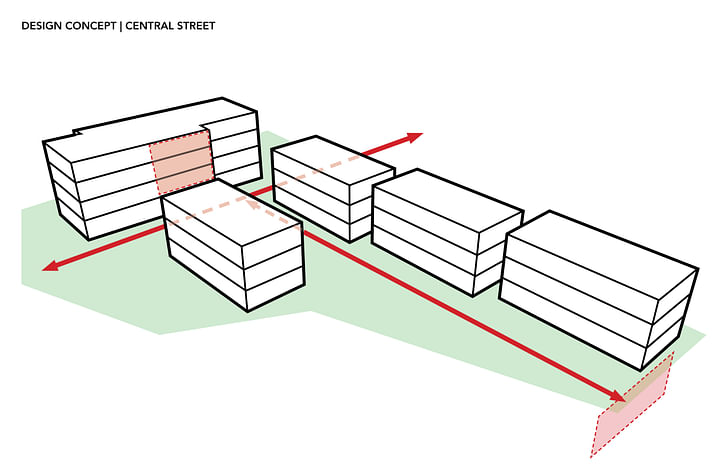

Archinect recently explored the architect's role in addressing homelessness in Los Angeles. We connected with Michael Pinto AIA and Helena Jubany FAIA, both principals at NAC Architecture, to discuss their work in tackling this social crisis. This previous discussion centered around the cruciality of collaboration and the power of impactful partnerships that enable participants to capitalize on their respective skills. The architect, in this sense, becomes one of many parties, with a specialized focus on the building environment, there to contribute expertise to a larger whole of volunteers, professionals, politicians, and advocates.
As we dove deeper into this investigation, we focused in on a new project led by the Los Angeles County USC Medical Center called the Restorative Care Village, a first-of-its-kind facility committed to receiving homeless individuals "wherever they are." Going beyond a mere shelter this facility will provide supportive housing, recuperative care, psychiatric help, and much more. NAC Architecture helped LA County develop the scoping documentation for the project. This documentation was then used to solicit proposals from a number of design build teams.
CannonDesign was awarded the design-build contract in 2019. I connected with David Hunt AIA, the Southern California Health Practice Leader at CannonDesign, to discuss the team's use of modular construction to realize this project for the County and some of the deeper implications of the final design.
CannonDesign was recently awarded the design-build contract for the LAC+USC Restorative Care Village project. What do you feel contributed to the County selecting CannonDesign’s proposal?
I believe we presented an exciting vision for the project that will help patients, strengthen the community, and maximize the site. All of these were key drivers for our selection. Behind the proposal too, we are uniquely positioned with our blend of design and construction services along with our decades-long history designing effective behavioral healthcare solutions. Our history with the County of Los Angeles on other projects, including the MLK Child and Wellbeing Center Project, shows we are a strategic partner with the county.
How does the design of this facility contribute to the surrounding community?
The LAC+USC Restorative Care Village really shines here. Foremost, this project will help people in LA County dealing with homelessness issues or mental health for generations. That’s a clear community benefit.
For people who have not had the stability of a home, the Restorative Care Village will be that place for them as they care for their physical and mental health
But, even more than that, this project is designed as a community asset. The courtyard areas welcome the community in, and it helps residents feel a sense of connectedness. Health is more than just physical well being-- where you live and your environment is a major contributor as well. For people who have not had the stability of a home, the Restorative Care Village will be that place for them as they care for their physical and mental health.
We’ve intentionally designed the LAC+USC Restorative Care Village not as a stigmatized place, but as places integrated in their communities for normal life, human experiences, recovery and partnership.

CannonDesign’s proposal embraces the use of modular construction. What benefits does this approach capitalize on for this project?
Modular construction is proven to accelerate project delivery, reduce cost and ensure high-quality built solutions. So, there are inherent benefits for any project that embraces modular construction. That said, the dynamic opportunity here is that the homeless population in LA County is so high, and the need so great - modular construction will make the LAC+USC Restorative Care Village a reality sooner as it can reduce the project schedule. It will help people sooner than if it was designed and built in a more traditional manner.
How does modular construction uniquely address the challenges in tackling homelessness?
A clear benefit of modular construction is speed-to-market. Often, speed-to-market translates to accelerated revenue capture, etc. but here it’s really about being able to help people sooner. I would encourage any health system or civic institution seeking an innovative solution to a public health crisis to consider modular construction as it will help those most in need sooner.

If we did a side-by-side comparison, how much longer would it have taken to develop this project by traditional means as opposed to modular and prefabrication?
That’s not overtly simple to answer. Modular design can bring projects to market 20-50% faster. I would say traditional construction would have added at least 4-6 months to this project schedule. The change in schedule really depends on the scope of the project and how many spaces can be created and replicated without customization.

Is modular and end-all-be-all? In what settings might its use be inappropriate?
It’s not an end-all-be-all. It’s a highly effective, proven construction method. However, for projects that require intense customization where there is very little replication throughout the design - those could be scenarios where I might not encourage modular design. However, I’d always encourage integrated design and delivery. The more you can create a single point of responsibility and a unified team, the better the project outcomes will be every time.
Tell me about the prefabrication process. Did this method introduce any particular design constraints to the team? How were they overcome?
The key is always to identify the most advantageous components to prefabricate, the most repeated rooms in a facility. With the Restorative Care Village, four of the five buildings are identical and a majority of the rooms are bedrooms - so there’s significant opportunity for standardization, repetition, etc. These are essential elements for positive prefabrication outcomes.

The proposed structures contain unique cladding patterns. What was the inspiration behind the design concept?
The building cladding was inspired by the historic architecture of LA County’s landmark General Hospital (this project sits on the General Hospital’s site). Multi-colored paneling in the project also takes cues from colorful murals in the surrounding neighborhoods.

What else should we know about this project and its development?
There’s a couple things I’d add, including:
LA County is opening four restorative care villages. Beyond the LAC+USC Restorative Care Village project, there is the MLK Behavioral Health Center, with 16 residential treatment beds, along with a variety of residential and outpatient treatment programs for mental health and substance use disorders, the Rancho Los Amigos National Rehabilitation Center, with 80 residential treatment beds and 50 recuperative care beds. The Olive View-UCLA Medical Center will hold 80 residential treatment beds and 48 recuperative care beds alongside mental health outpatient and urgent care centers.
Community meetings really shaped this project and helped us determine the two main components for the LAC+USC Restorative Care Village project. Those are:
A four-story Recuperative Care Center with 96 beds to provide immediate placement options for persons being discharged from an inpatient hospital setting who lack a supportive place to live.
A 64-bed Residential Treatment Program consisting of four buildings that provide a short-term alternative to hospitalization to address mental health needs.
The Care Villages are designed to provide residents with a full continuum of services - recuperative care, supportive housing, a rest and recovery center plus psychiatric services - alongside education, training, employment and recreational and social amenities.
Sean Joyner is a writer and essayist based in Los Angeles. His work explores themes spanning architecture, culture, and everyday life. Sean's essays and articles have been featured in The Architect's Newspaper, ARCHITECT Magazine, Dwell Magazine, and Archinect. He also works as an ...
1 Comment
where are the buildings being manufactured?
Block this user
Are you sure you want to block this user and hide all related comments throughout the site?
Archinect
This is your first comment on Archinect. Your comment will be visible once approved.